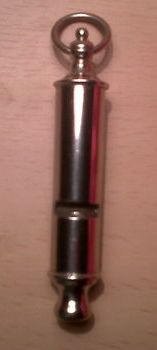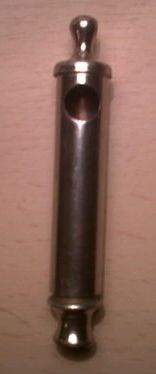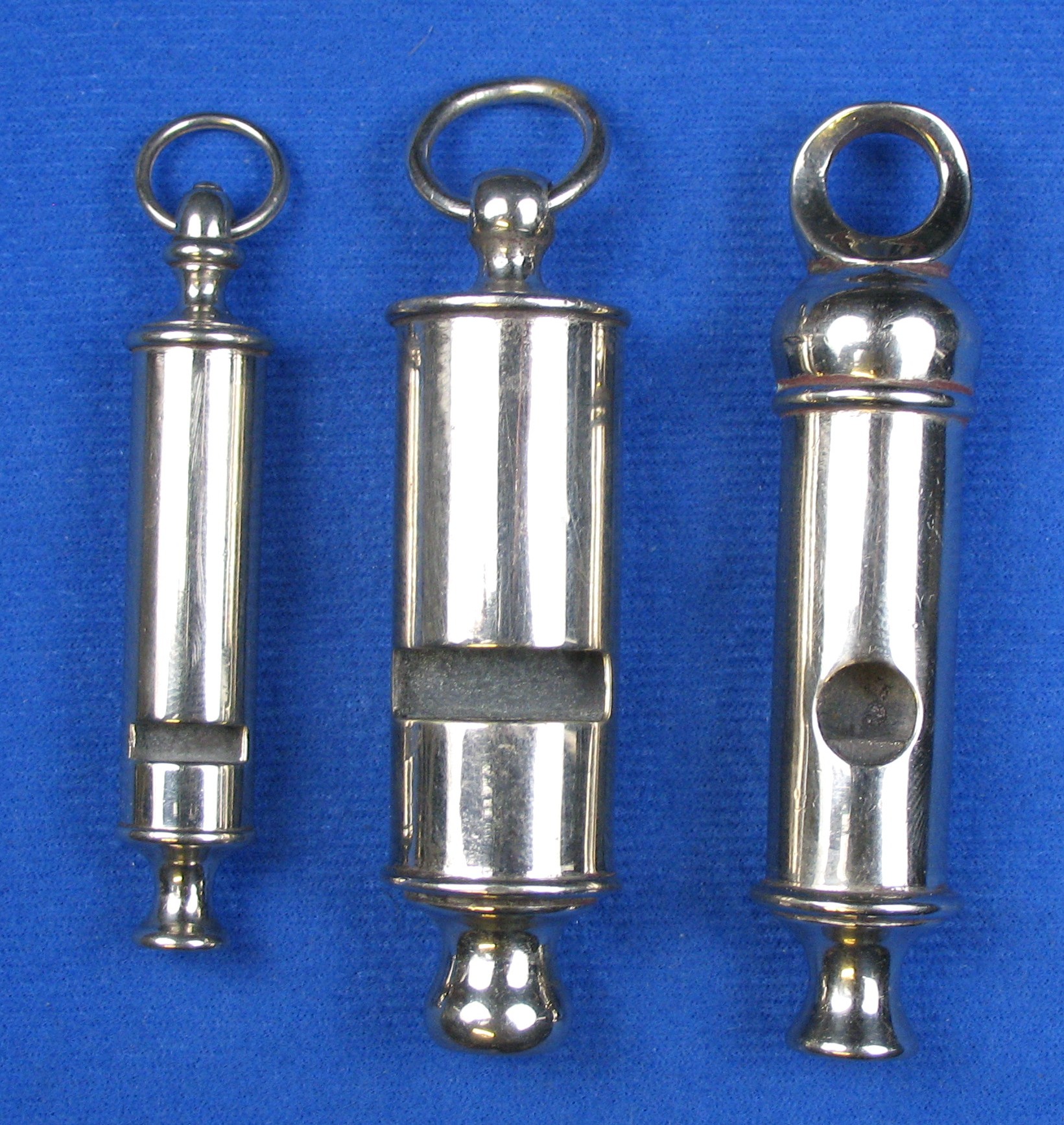Spotlight > Whistle Maker by Country > United Kingdom > Hudson > 021 Early Hudson GSWs
Whistory
Some Hudson ‘whistles never put into general production’ is written on page 41 of CPWs, along with a picture of four whistles. How early were they made and at what address one wonders? From Martyn Gilchrist’s records retrieved, along with Simon Topman from Hudson’s storehouse of information, we understand that Joseph Hudson started working at 12 years of age.
Hudson Early Days
He worked in the 1860s at Bent and Parker and learned how to make whistles. Perhaps starting as an outworker about 1870 he moved to 7 House, Court 3, Bell Barn road and then to 17 Mark’s Street in the St Mark’s Cottages about 4 years later – 1874. He stayed there till 1882 when he moved to 84 Buckingham Street close to the Jewelry District.
The question begs to be asked, —- what whistles did he make in those 12 years prior ?? He and his brother did take out a patent for a corkscrew whistle IN 1876 ( see SPOTLIGHT 66 ) CPWs also notes that he made handmade whistles and corkscrews there. Page 6 of CPWs features two very early police issues, including one with an ivory mouthpiece and no partition.
What Challenges Existed for Hudson
The challenge comes to identifying whistles made by Hudson in those early years – over ten years. Over a decade of whistles unidentified as yet that can be assigned to that period. The whistle on the left shown in the picture in CPWs came up on eBay, but unfortunately, we could not afford to get it at the time See figure one below ).
We would have loved to include the picture of that whistle grouped along with the other three that we did manage to retrieve. Another very remarkable whistle came up, that had the windows at the top by the ring ( see figure two below ). — It looked to be another Hudson, but does not match the age, looking to have a rolled mouthpiece.
Refer to page 41 of Collecting Police Whistles and Similar Types by Gilchrist and Topman.
Whistle Classification
| Category | tube shape |
| Order | Hudson |
| Type | general |
| Class | nickel silver |
| Sub class | mono-typical prototypes |
Whistle Archeology
Four whistles are pictured, and others exist of prototypes not released to the public. It appears that these came up for auction and were distributed. Three are in the reference collection and two others are pictured that went to other collectors.
Whistology
First, we will look at an overall picture posed just like the book, however missing the one on the left.
Then we will look at each whistle individually for close examinations and hopefully derive some conclusions in our constant effort for accurate research.
A Couple Hudson That Were Not Obtained
Your comments and help are always encouraged and together we can put together some better descriptions.


Left: “figure one”; Right: “figure two”

Right away you can see that there is a similarity in a period of workmanship, to these. The other one ( figure one ) mentioned above also matches this period. Comparatively you can take in the size differences. The missing one on the left ( from CPWs pictured group of four ) is similar to the first one here on the left, but a little taller. Now let’s look at each in turn.
What to look for in the first one is that it is very skinny — quite unusual for Hudson whistles until much later in production. It is a very high quality whistle. The top knop is also unusual for Hudson. Its influence with the top knops can be seen in early Dixon rounds, but also can be seen in Ward rounds. To find it on a GSW is unusual. The attachment is set back with a slight reveal and inset edge, also exceptional. Beyond that it has a tall knop. Really, a fantastic job and we have only talked about the top.
It has a partition so, would date it no earlier than 1870 if compared to Stevens, likely later than 1880s, but Gilchrist lists all of these as 1900s. We can only think that this must be from records at Hudson’s. Otherwise the influences and styles suggest an earlier period, not to mention the materials being cast top, inside parts and mouthpiece.
Consider the mouthpiece being cast. It is also long for such a small whistle. The inside is well crafted and smooth and the disc is cast, which would point to an earlier period. This would not match 1900, but brings us back to circa 1880, pre or post, as cast parts like these were, for the most part, left behind by 1885.
The windows are very low cut and just not seen on later models, nor any others for that fact, but effectively give the whistle a sleek longer look even though more on the petite side.

Now let’s move on to the remarkably wide GSW. You cannot help but be impressed with the ‘bulk’ of it. It is not as heavy as it looks, but rather light. The ring is soldered/brazed closed, usually a sign of a better-quality manufacturer and this one does not disappoint.

We see a rather simple round knop. Round knops were seen late 1800s by Yates and Hudson and others. However, they pretty much went out of production by 1900, except for DeCourcy. Again we have here a cast disc set against a partition. The mouthpiece is cast. However the application to the body is set back with a most definite reveal to it, making it look like a ‘step’ to the design. Here we see some influence from Yates who was very active in the 1870s, 80’s.
Lastly, we close in on an indisputably early whistle. A Porteous top with round windows. What influences do we see here ?? Definitely Stevens, and earlier Porteous himself, can be seen in the shape of the Porteous top, however Dowler too. Both were active 1880s. It is nothing like later Porteous tops that Hudson made, especially moving towards 2 piece ones.
The windows would definitely date the whistle earlier, as the only influence we see here is from beauforts which can date from the mid 1800s or earlier.

Now add to this the diaphragm being a cast wedge-like design. The application is done as a wedge, but it is flattened off when looking into the mouthpiece. Gilchrist matches it up to the patent 435 in the KING whistles with the same design. That would date the whistle to 1885 or later. But does it ??
Interestingly, Coney, Stevens and Bent and Parker all produced whistles with the word PATENT stamped on them and no patent filed can be found. The KING whistle designed by Hudson can be found with PATENT stamped on it, —- but having the regular wedge inside. Were there so many KINGS made at that time that old parts were being put in ?? Few KINGS can be found as it is. And they do date clear back to 84 Buckingham street times.
Add to this that the disc is cast, quite thick and no ‘wings’ or tines are attached to the partition for soldering and stability to the sidewalls—the main reason for the improvement to replace the ‘shaky’ Metropolitan designed partitions and discs that came loose. All these are parts of what the patent that was filed for and described.
Conclusions:
What conclusions might we draw ?? Well lets’ recap some of what we have examined…
- Influence by early manufacturers like Yates, and Dowler circa 1870-80
- Cast mouthpieces, — which went by the wayside by 1885 ( except for King whistles )
- Unique designs later abandoned ( i.e. windows, step backs, tops )
- Very high quality handmade whistles.
- Internal parts that were cast and also abandoned by 1885
When we put together the evidence suggests 17 Mark’s Street to be weak, to 84 Buckingham, still weak and even the 131 Barr address a bit early, leaving most likely at 13 street Barr address circa 1890.
Perhaps the next time a few others surface we will be better able to afford them and add to this section and hopefully there will be and even better window into this time period.
TWG
Posted September 1, 2013
Revised September 12, 2020
Revised February 12, 2021
Revised December 30, 2021
Posted June 12, 2022
Bibliography:
Collecting Police Whistles, Gilchrist & Topman
Birmingham Industrial Heritage R M Shill 2002
The Whistle Gallery Reference Collection
© – All photos with blue background property of The Whistle Gallery reference collection. Please contact The Whistle Gallery for permission of use of any website content. Spotlight articles are copyrighted. Please contact The Whistle Gallery for permission of use of any website or Spotlight article material written or otherwise. Use of photos without authorization is prohibited.









